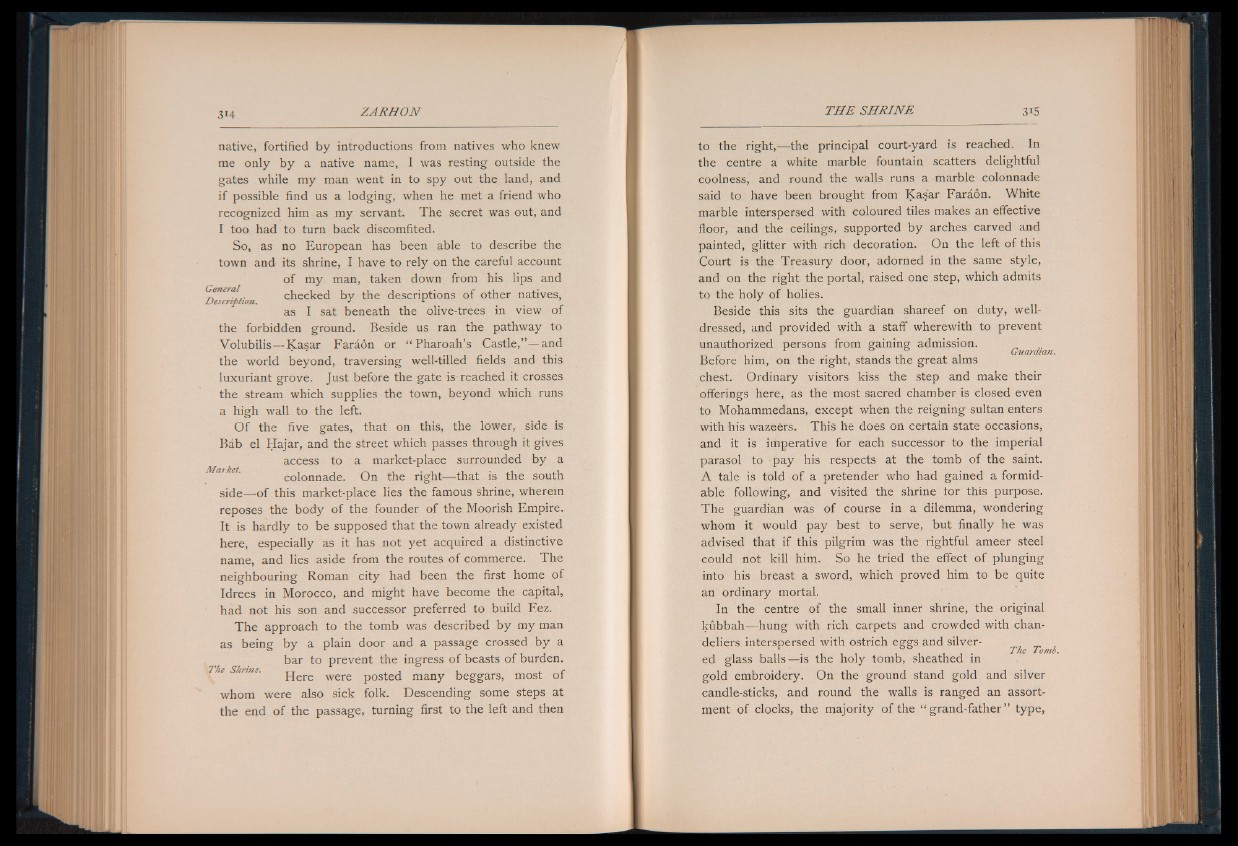
native, fortified by introductions from natives who knew
me only by a native name, I was resting outside the
gates while my man went in to spy out the land, and
if possible find us a lodging, when he met a friend who
recognized him as my servant. The secret was out, and
I too had to turn back discomfited.
So, as no European has been able to describe the
town and its shrine, I have to rely on the careful account
of my man, taken down from his lips and
Description. checked by the descriptions of other natives,
as I sat beneath the olive-trees in view of
the forbidden ground. Beside us ran the pathway to
Volubilis— Kasar Faraon or “ Pharoah’s Castle,”— and
the world beyond, traversing well-tilled fields and this
luxuriant grove. Just before the gate is reached it crosses
the stream which supplies the town, beyond which runs
a high wall to the left.
O f the five gates, that on this, the lower, side is
Bab el Hajar, and the street which passes through it gives
access to a market-place surrounded by a
colonnade. On the right— that is the south
side— of this market-place lies the famous shrine, wherein
reposes the body o f the founder of the Moorish Empire.
It is hardly to be supposed that the town already existed
here, especially as it has not yet acquired a distinctive
name, and lies aside from the routes of commerce. The
neighbouring Roman city had been the first home of
Idrees in Morocco, and might have become the capital,
had not his son and successor preferred to build Fez.
The approach to the tomb was described by my man
as being by a plain door and a passage crossed by a
bar to prevent the ingress of beasts of burden.
Here were posted many beggars, most of
whom were also sick folk. Descending some steps at
the end of the passage, turning first to the left and then
to the right,— the principal court-yard is reached. In
the centre a white marble fountain scatters delightful
coolness, and round the walls runs a marble colonnade
said to have been brought from Kasar Faraon. White
marble interspersed with coloured tiles makes an effective
floor, and the ceilings, supported by arches carved and
painted, glitter with rich decoration. On the left of this
Court is the Treasury door, adorned in the same style,
and on the right the portal, raised one step, which admits
to the holy of holies.
Beside this sits the guardian shareef on duty, well-
dressed, and provided with a staff wherewith to prevent
unauthorized persons from gaining admission.
1 1 Guardian.
Before him, on the right, stands the great alms
chest. Ordinary visitors kiss the step and make their
offerings here, as the most sacred chamber is closed even
to Mohammedans, except when the reigning sultan enters
with his wazeers. This he does on certain state occasions,
and it is imperative for each successor to the imperial
parasol to pay his respects at the tomb of the saint.
A tale is told of a pretender who had gained a formidable
following, and visited the shrine for this purpose.
The guardian was of course in a dilemma, wondering
whom it would pay best to serve, but finally he was
advised that if this pilgrim was the rightful ameer steel
could not kill him. So he tried the effect of plunging
into his breast a sword, which proved him to be quite
an ordinary mortal.
In the centre of the small inner shrine, the original
kubbah— hung with rich carpets and crowded with chandeliers
interspersed with ostrich eggs and silver-
. . The Tomb
ed glass balls—is the holy tomb, sheathed in
gold embroidery. On the ground stand gold and silver
candle-sticks, and round the walls is ranged an assortment
of clocks, the majority of the “ grand-father ” type,